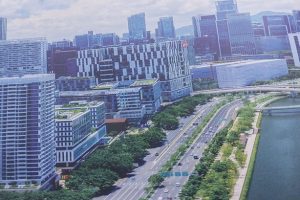BY DARGIE KAHSAY
Urban centers are abounded by various factors with a potential of increasing the temperature of the area and different air polluting gases as most vehicles, factories and other chemicals mostly reside within and around urban centers. In addition, due to the growing impacts of climate change, urban areas and the population dwelling in urban areas are increasingly affected by these developments. Not only that, the expansion of urbanization is contributing its own share in increasing the devastating impacts of climate change since it changes the environmental features of the area.
Expansion of urbanization contributes in deforestation since it expands at the cost of the environmental safety. Hence, the expansion and development of urban areas is a cause for trees losses. Though trees in urban areas have multidimensional benefits, these trees are in risks, a new study revealed. In addition to their life saving role by feeding clean air to the dwellers, urban trees have also a beautification role. Though, trees in and around urban centers have multidimensional benefits, these trees are also facing serious problems due to climate change and the nature of the urban areas.
A new global study concludes the health and survival of urban trees is endangered due to climate change, adding almost more than half of the tree species in urban areas are already feeling the heat, the study underlines. Urban trees play an essential role in the well-being and health of urban dwellers, but due to increase in temperature, these trees planted in urban centers are at risk.
According to the first global risk assessment for tree species in cities, currently due to an increase in temperature and decrease in annual rainfall due to climate change, 56 to 65 percent of urban tree species are already at risk. The Study predicts that this risk figure of urban tree species could rise to 68-78 percent by 2050.
According to an international research team’s first global risk assessment for species planted in urban areas, climate change threatens the health and survival of urban trees with more than half of the tree species are at high risk. According to the findings of the study, “city-dwelling oaks, maples, poplars, elms, pines and chestnuts are among more than 1,000 tree species flagged at risk due to climate change.” The scientists argued that, with the current trend, the survival of urban trees is at risk and without these trees; living within urban centers would be very tough.
“Trees have cooling effects and provide shade, making cities more livable,” the scientists argued and recommended the protection of the existing trees and to be planted drought-resistant species varieties for the continuity of the urban trees in the current trends of climate change.
The scientists used the Global Urban Tree Inventory for their research -a database recording more than 4,000 different trees and shrubs planted in 164 cities in 78 countries – to assess the likely impact of global warming on the trees planted along streets and in parks.
Citing the global research, BBC reported that of the 164 cities analyzed, more than half of tree species are already at risk in some cities due to rising temperatures and changes in rainfall. And by 2050, this proportion is predicted to rise to more than two-thirds, which shows the increasing risk of the urban trees with the current trend. This trend is an alarm to give due attention to protect these lifesaving trees by minimizing the factors and planting more resilient species.
According to the findings of the research, climate risk for species in urban areas is particularly high in cities found in tropical regions and in more vulnerable countries. The research published at the journal of Nature Climate Change further argued that drier weather under climate change is expected to have big impact on urban trees.
The study confirmed that all urban tree species are vulnerable to climate change, adding this affects the various benefits that urban trees are delivering to urban inhabitants. Though all tree species in urban areas are vulnerable to climate change, according to the study, it predicts greatest risk for trees found in cities at low latitudes. Unless necessary measures are taken timely, it is tough to secure long-term benefits provided by urban forests since the trees themselves are at risk of survival.
Member of the research team, Manuel Esperon-Rodriguez of Western Sydney University in Penrith, Australia told BBC that many trees in urban areas are stressed because of climate change and as it gets warmer and drier, he said adding, the number of species at potential risk will increase. As to him, city and street trees can improve physical and mental health and can mitigate the effects of temperature rises.
For the research team, all trees in urban areas are facing similar risk due to the climate condition and watering trees regularly is a solution to mitigate the impact of climate change. As to the findings, risks are projected to increase in the future. “With trees playing an increasingly critical role as natural air conditioners in cities during heat waves, these findings show that urban greening schemes must be adapted to allow trees to cope with climate change, for example, by planting species resilient to future temperatures and precipitation,” the research finding underlined.
According to the scientists, urban areas are highly polluting areas and these trees make the urban areas safe for the residents as they absorb the emitted gases to the air and release oxygen to the air. So far, the big mature trees are providing the benefits in the urban areas and the finding recommends the need to grow the trees planting today so as to benefit the future generations.
In this regard, the researchers recommend that planting more climate resilient trees and caring for the currently available trees especially during dry seasons. Hence, giving due attention to green spaces in urban centers, planting trees and caring to grow them and caring the available trees especially by watering them during dry seasons are among the solutions to protect the survival and health of urban trees worldwide.
In addition, urban centers should protect trees from cutting during constructions of buildings and infrastructural expansion since these trees are essential for lives. Hence, expansion of green spaces in urban areas, protecting and caring for the available trees is a critical issue that all urban areas around the world should apply as climate change and its impacts are growing at fastest rate with multidimensional implications.
In its Green Legacy imitative implemented for four years Ethiopia has given due attention in planting trees in urban areas. Billions of trees were planted in all cities and towns across Ethiopia as the country striving to increase its forest coverage as well as combating climate change and its impacts.





